The Effect of Pulling Speed on the Structure and Properties of DZ22B Superalloy Blades
Abstract
1. Introduction
2. Establishment of ProCAST Numerical Simulation Model
2.1. Pre-Process Run Parameters
2.2. Casting and Mold Shell Model Building and Meshing
2.3. Temperature Field Heat Transfer Model
2.4. Grain and Dendrite Growth Models
2.5. Thermal Crack Susceptibility Model
3. Procast Numerically Simulates the Effect of Pulling Speed on DZ22B Superalloy Blades
3.1. Effect of Pulling Speed on Temperature Field of DZ22B Superalloy Blade
3.2. Effect of Pulling Speed on the Microstructure of DZ22B Superalloy Blades
3.3. Effect of Pulling Speed on the Thermal Cracking Tendency of DZ22B Superalloy Blade
3.4. Experimental Verification
4. ProCAST Numerically Simulates the Effect of Variable Speed Pulling Process on DZ22B Superalloy Blades
4.1. Effect of Variable Speed Pulling on Temperature Field of DZ22B Superalloy Blade
4.2. Effect of Variable Speed Pulling on the Thermal Cracking Tendency of DZ22B Superalloy Blade
4.3. Experimental Verification
5. Conclusions
Author Contributions
Funding
Institutional Review Board Statement
Informed Consent Statement
Data Availability Statement
Conflicts of Interest
References
- Xiao, X. Thermal fatigue behaviors of three cast nickel base superalloys. Acta Met. Sin 2011, 47, 1129–1134. [Google Scholar]
- Khan, M.A. Oxidation and hot corrosion behavior of nickel-based superalloy for gas turbine applications. Mater. Manuf. Process 2014, 29, 832–839. [Google Scholar] [CrossRef]
- Zhang, S. Anisotropie creep rupture properties of a nickel-base single crystal superalloy at high temperature. J. Mater. Sci. Technol. 2011, 27, 107–112. [Google Scholar] [CrossRef]
- Liu, C. Effect of withdrawal rates on microstructure and creep strength of a single crystal superalloy processed by LMC. J. Mater. Sci. Technol. 2010, 26, 306–310. [Google Scholar] [CrossRef]
- Han, G. Effect of threshold stress on anisotropic creep properties of single crystal nickel-base superalloy SRR99. J. Mater. Sci. Technol. 2012, 28, 439–445. [Google Scholar] [CrossRef]
- Liu, Y. Interaction between CA6-MA crucible and molten wrought Ni-based superalloys. J. Eur. Ceram. Soc. 2023, 43, 1714–1722. [Google Scholar] [CrossRef]
- Su, S.A. The formation and evolution of stray grains in remelted interface in the seed crystal during the directional solidification of single crystal superalloys assisted by vertical static magnetic field. J. Acta Met. Sin 2022. [Google Scholar] [CrossRef]
- Li, F. Investigation of fused alumina based-mold facecoats for DZ22B directionally solidified blades. Materials 2019, 12, 606. [Google Scholar] [CrossRef]
- Liu, Y.N. Phase Transformation Process and Solidification Microstructure Transition of DZ22B superalloy. J. East China Jiaotong Univ. 2018, 35, 99–104. [Google Scholar]
- Li, Z. Effect of Slurry Thickness on the Quality of Aluminized Coatings. J. Mater. 2022, 15, 6758. [Google Scholar] [CrossRef]
- Yan, X. Investigation on material’s fatigue property variation among different regions of directional solidification turbine blades—Part I: Fatigue tests on full scale blades. J. Eng. Gas Turbine Power 2014, 136, 102502. [Google Scholar] [CrossRef]
- Xu, Z. Experimental study on mechanical properties of silica-based ceramic core for directional solidification of single crystal superalloy. Ceram. Int. 2018, 44, 394–401. [Google Scholar] [CrossRef]
- Kanyo, J.E. An overview of ceramic molds for investment casting of nickel superalloys. J. Eur. Ceram. Soc. 2020, 40, 4955–4973. [Google Scholar] [CrossRef]
- Du, B. Investigation on the microstructure and tensile behavior of a Ni-based IN792 superalloy. Adv. Mech. Eng. 2018, 10, 1687814017752167. [Google Scholar] [CrossRef]
- Zhao, Y. Phase-field simulation for the evolution of solid/liquid interface front in directional solidification process. J. Mater. Sci. Technol. 2019, 35, 1044–1052. [Google Scholar] [CrossRef]
- Shen, Y. Micro-segregation study of directional solidified Fe-Mn-C-Al TWIP steels. Met. Mater. Trans. 2020, 51, 2963–2975. [Google Scholar] [CrossRef]
- Zhu, C.S. Multi-phase field simulation of competitive grain growth for directional solidification. Chin. Phys. B 2022, 31, 068102. [Google Scholar] [CrossRef]
- Zhu, K. Mechanism of primary Si and Fe-segregation for a hypereutectic 90 wt.% Si-Ti alloy melt in directional solidification via electromagnetism. J. Iron Steel Res. Int. 2023, 30, 726–735. [Google Scholar] [CrossRef]
- Gao, Z. Multi-phase field model simulation based on MPI+ OpenMP parallel: Evolution of seaweed and dendritic structure in directional solidification. J. AIP Adv. 2022, 12, 035018. [Google Scholar] [CrossRef]
- Fang, H. Effects of Heating Power on Microstructure Evolution and Tensile Properties at Elevated Temperature by Directional Solidification for Ti2AlC/TiAl Composites. J. Adv. Eng. Mater. 2022, 24, 2100736. [Google Scholar] [CrossRef]
- Yu, F. The influence of anisotropy on the evolution of interfacial morphologies in directional solidification: A phase-field study. arXiv 2022, arXiv:2210.15673. [Google Scholar]
- The editorial board of china aeronautical materials handbook. DZ22B; In China Aeronautical Materials Handbook; Publishing House: Beijing, China, 2002; pp. 751–757.
- Qingyan, X. Progress on modeling and simulation of directional solidification of superalloy turbine blade casting. China Foundry 2012, 9, 69–77. [Google Scholar]
- Rappaz, M. Probabilistic modelling of microstructure formation in solidification processes. Acta Metall. 1993, 41, 345–360. [Google Scholar] [CrossRef]
- Gandin, C. A three-dimensional cellular automation-finite element model for the prediction of solidification grain structures. Met. Mater. Trans. 1999, 30, 3153–3165. [Google Scholar] [CrossRef]
- Kurz, W. Theory of microstructural development during rapid solidification. Acta Metall. 1986, 34, 823–830. [Google Scholar] [CrossRef]
- Zhu, J. Numerical modeling of hot tearing formation in metal casting and its validations. Int. J. Numer. Methods Eng. 2011, 87, 289–308. [Google Scholar] [CrossRef]
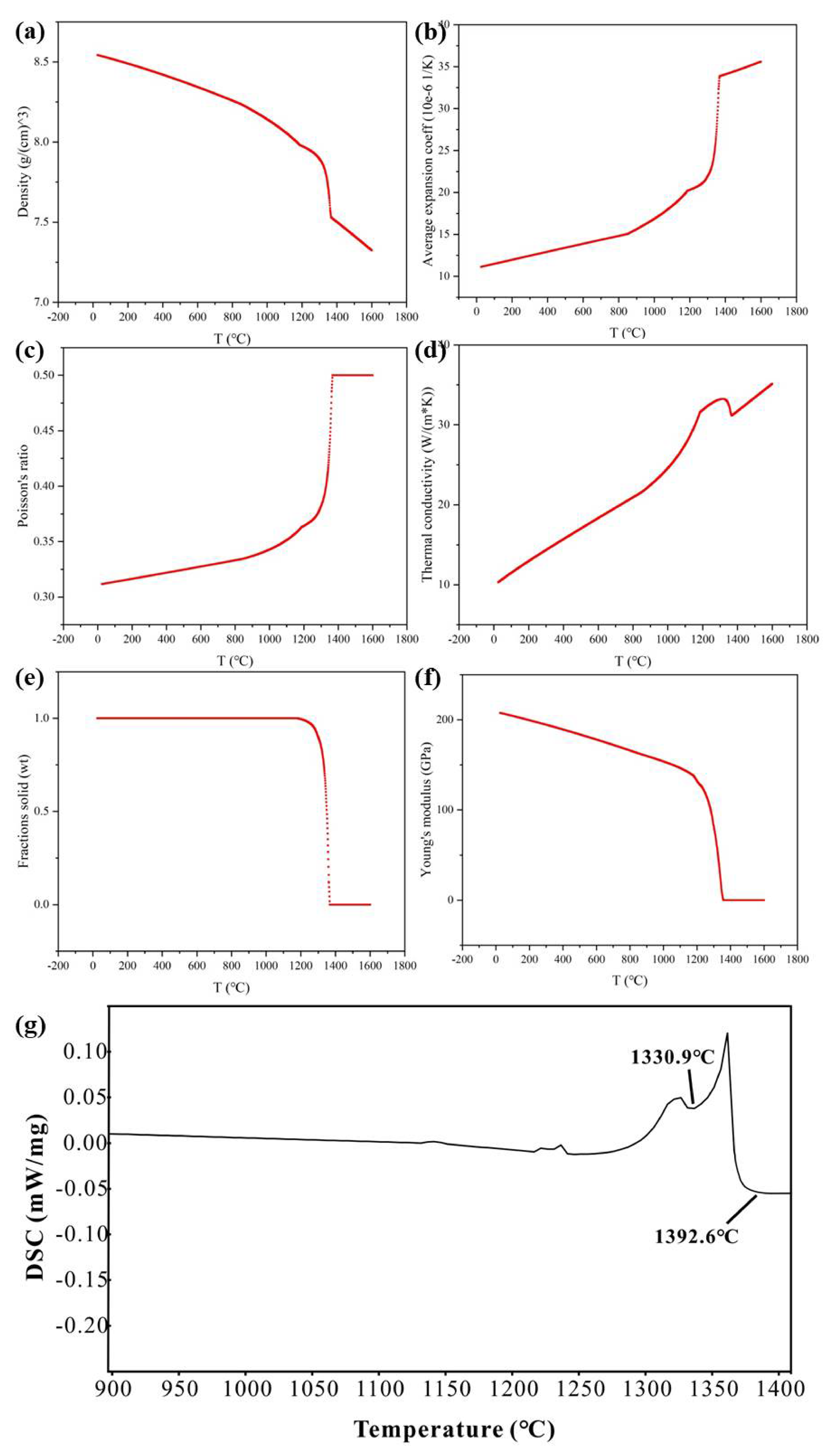
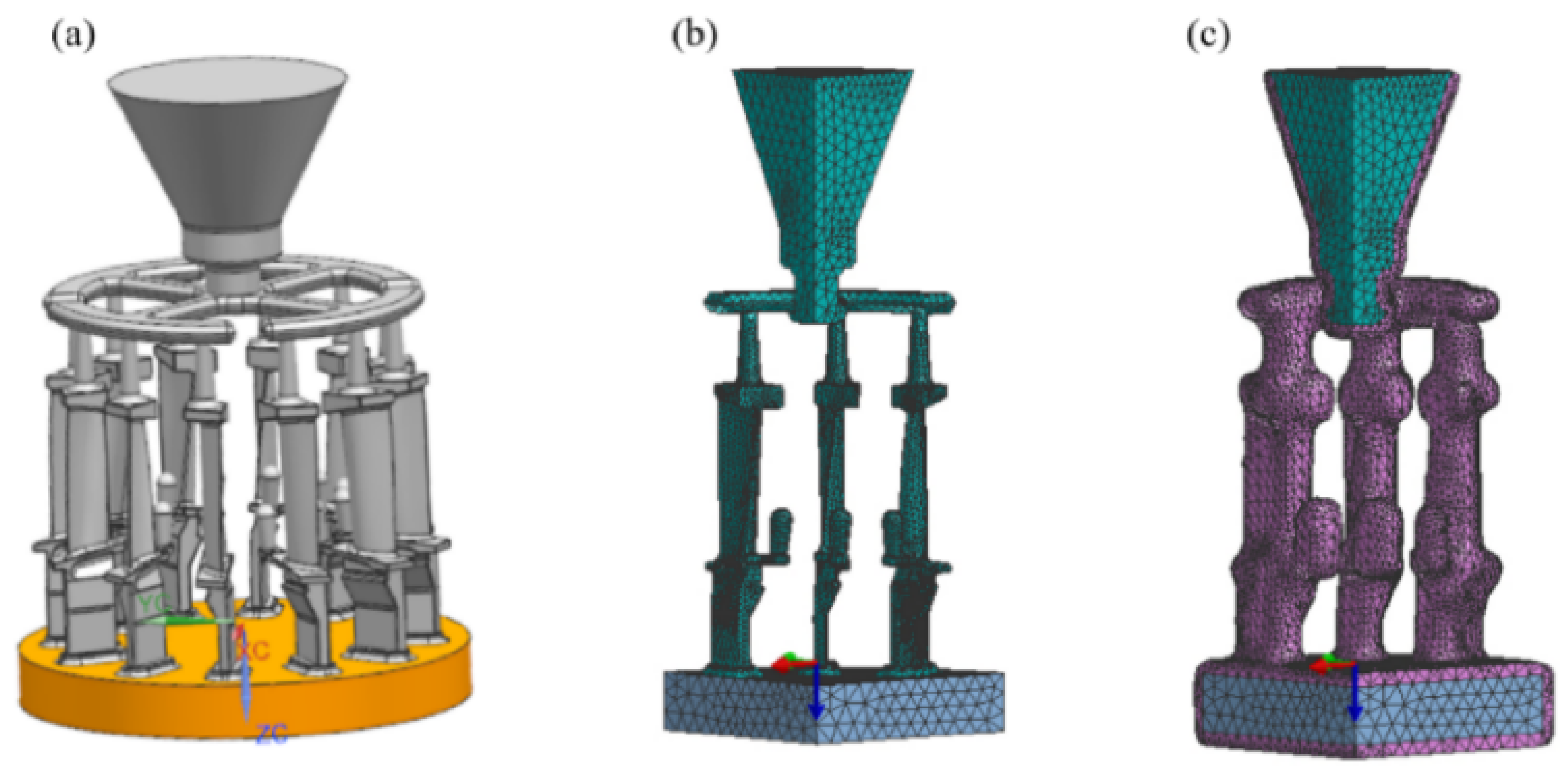
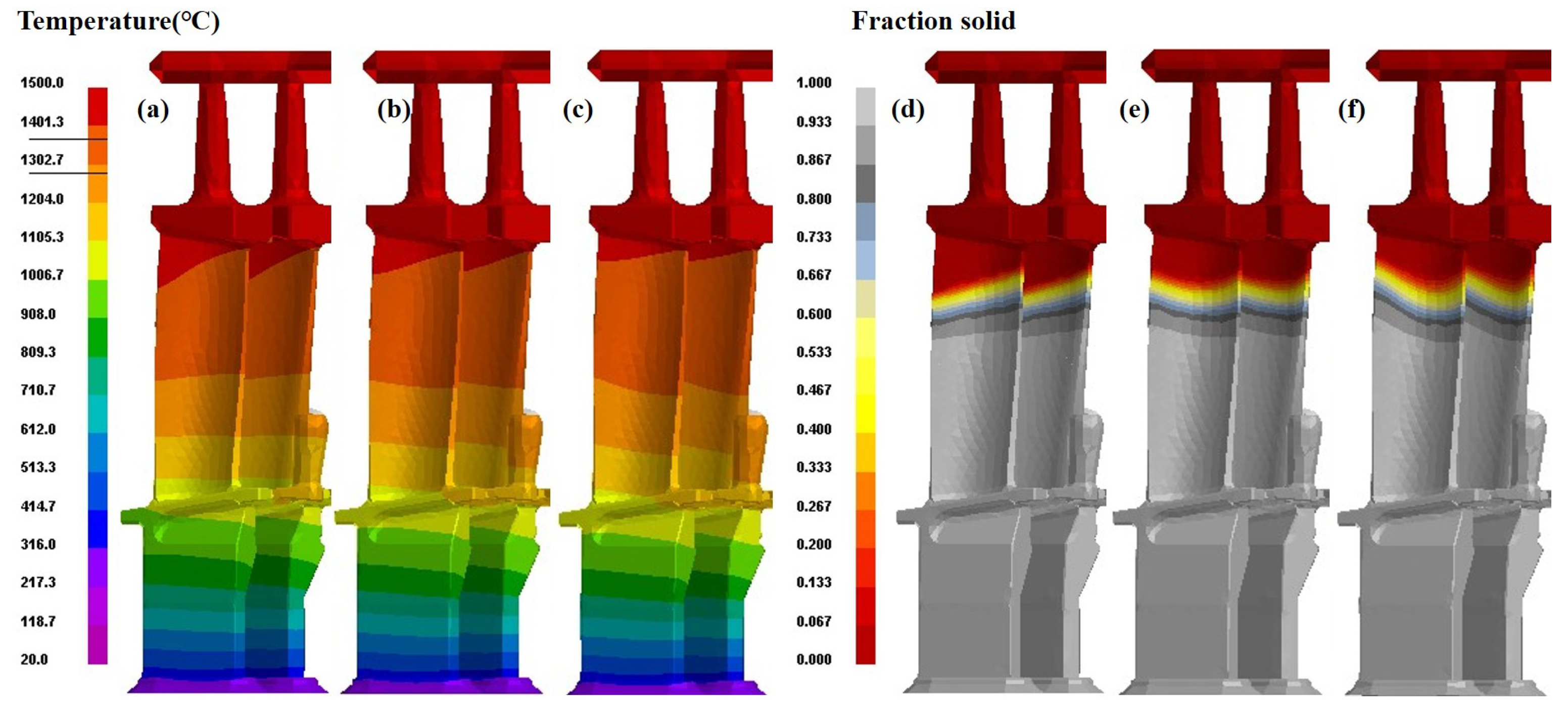
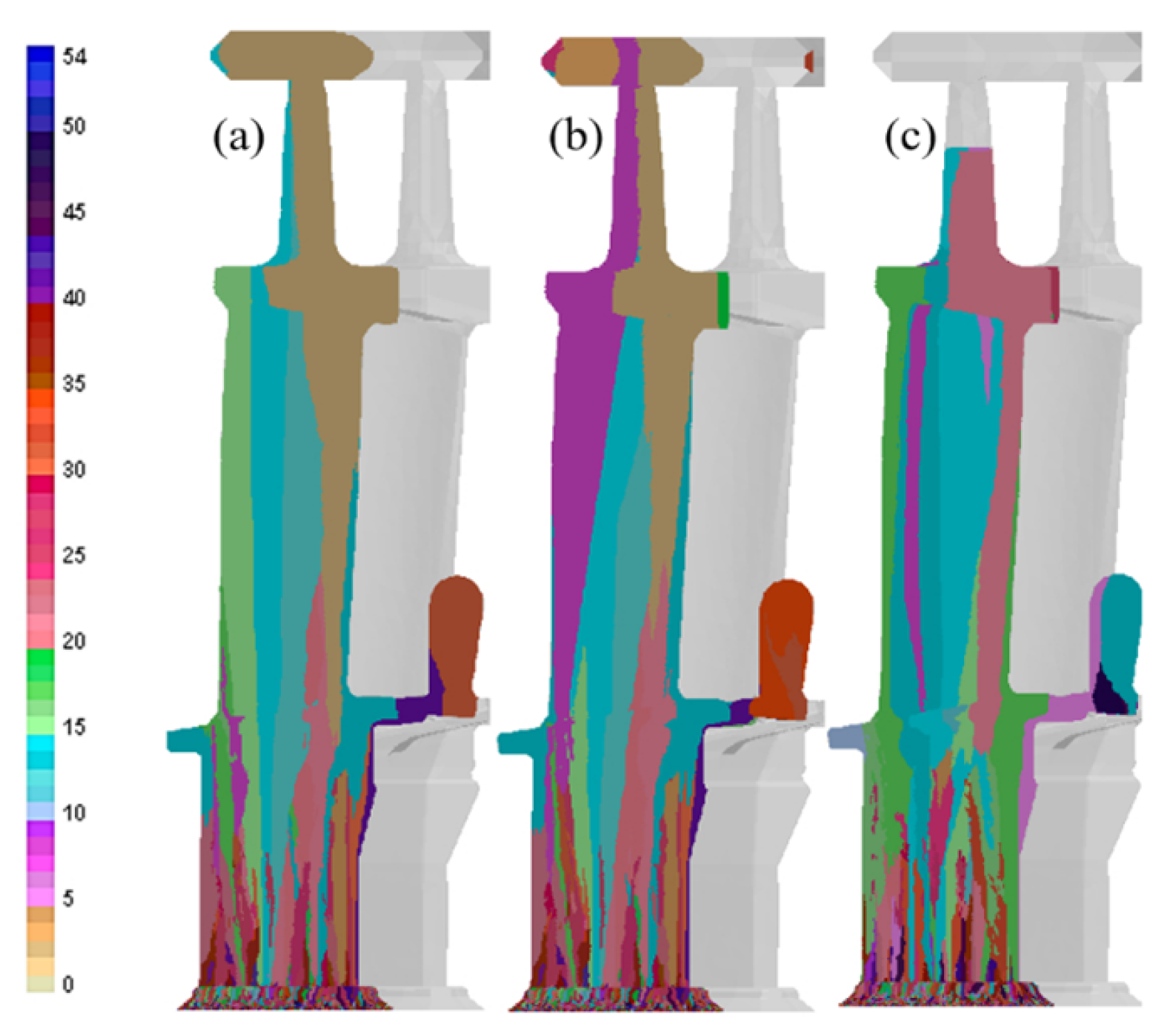


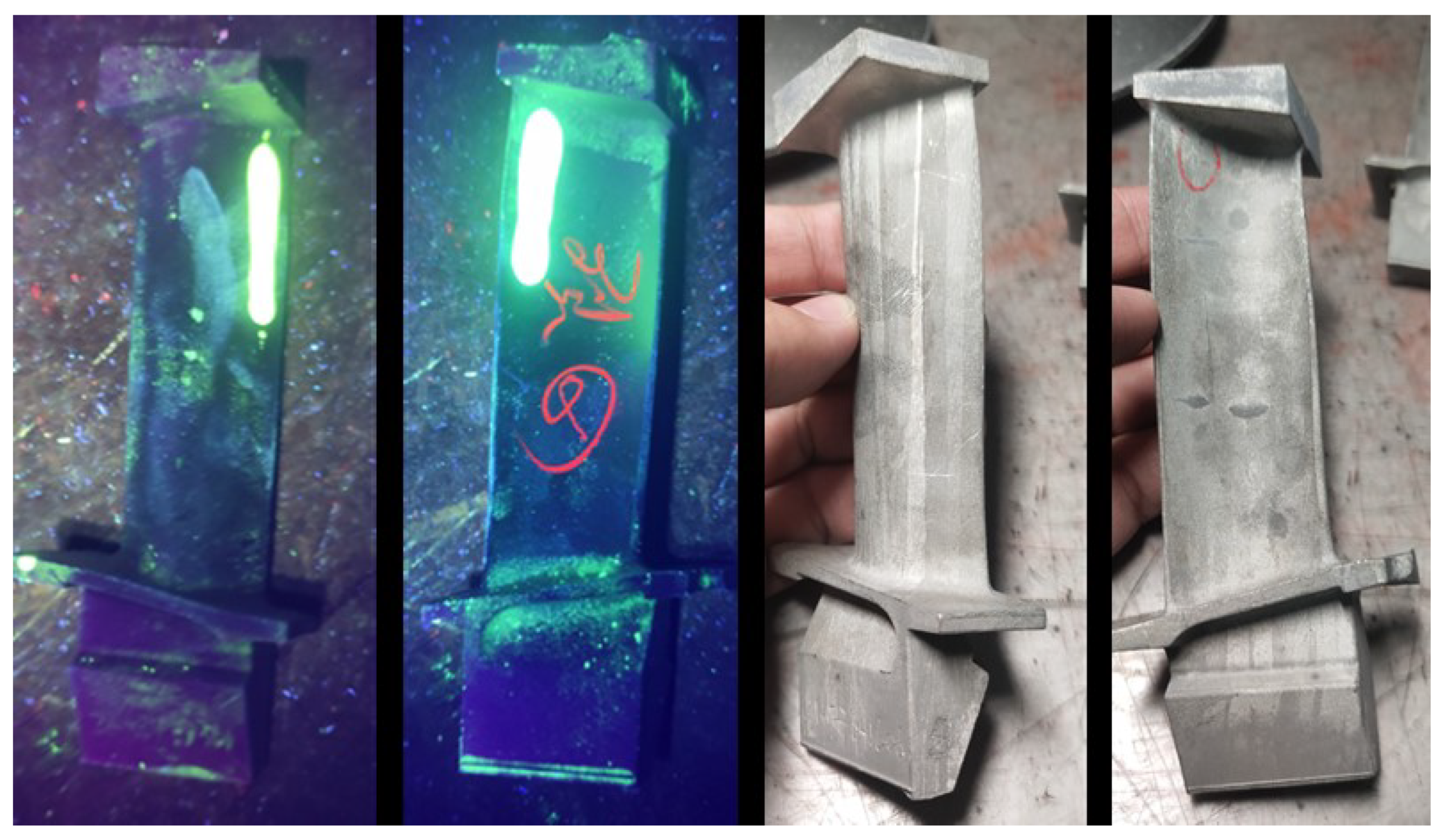


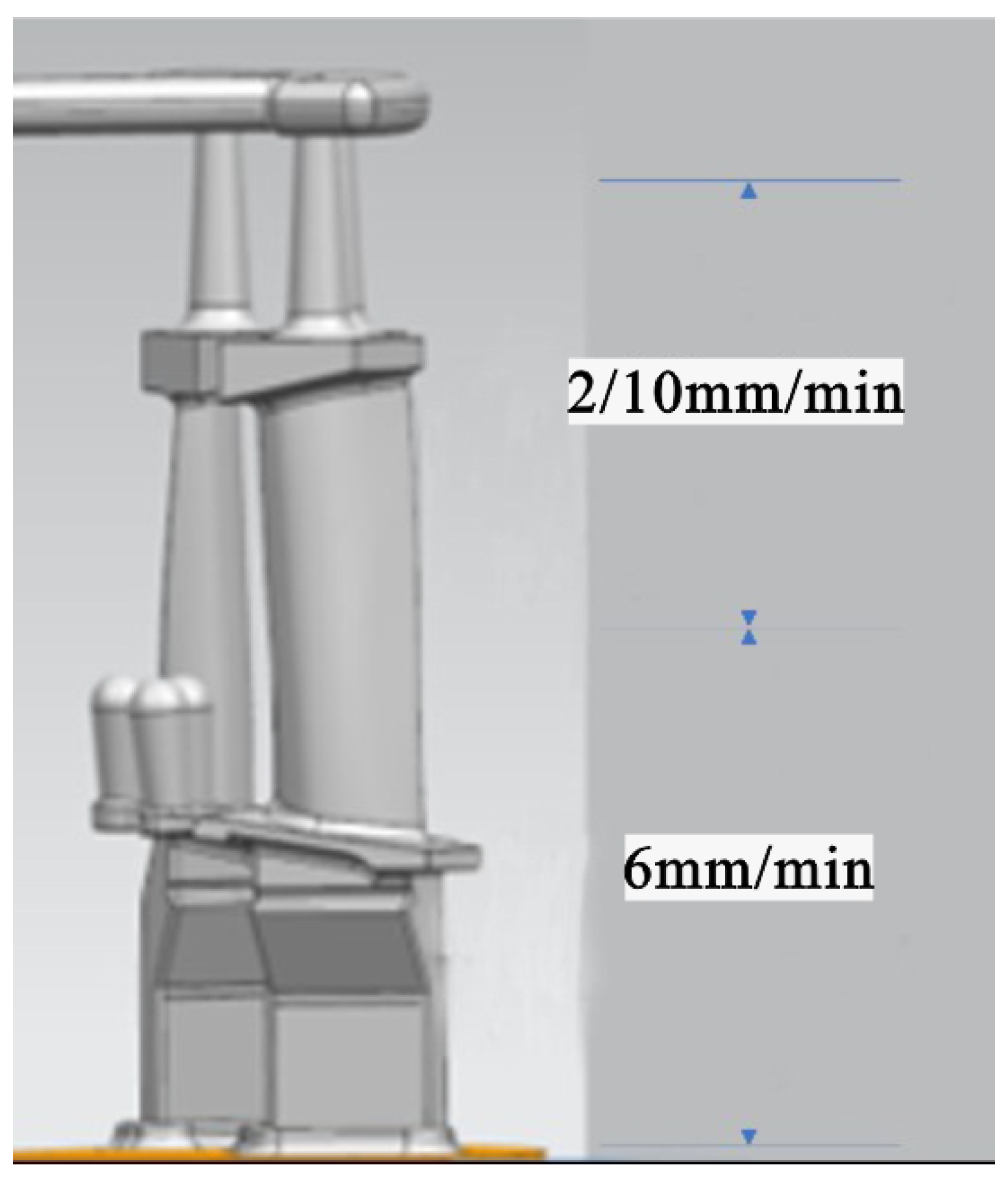
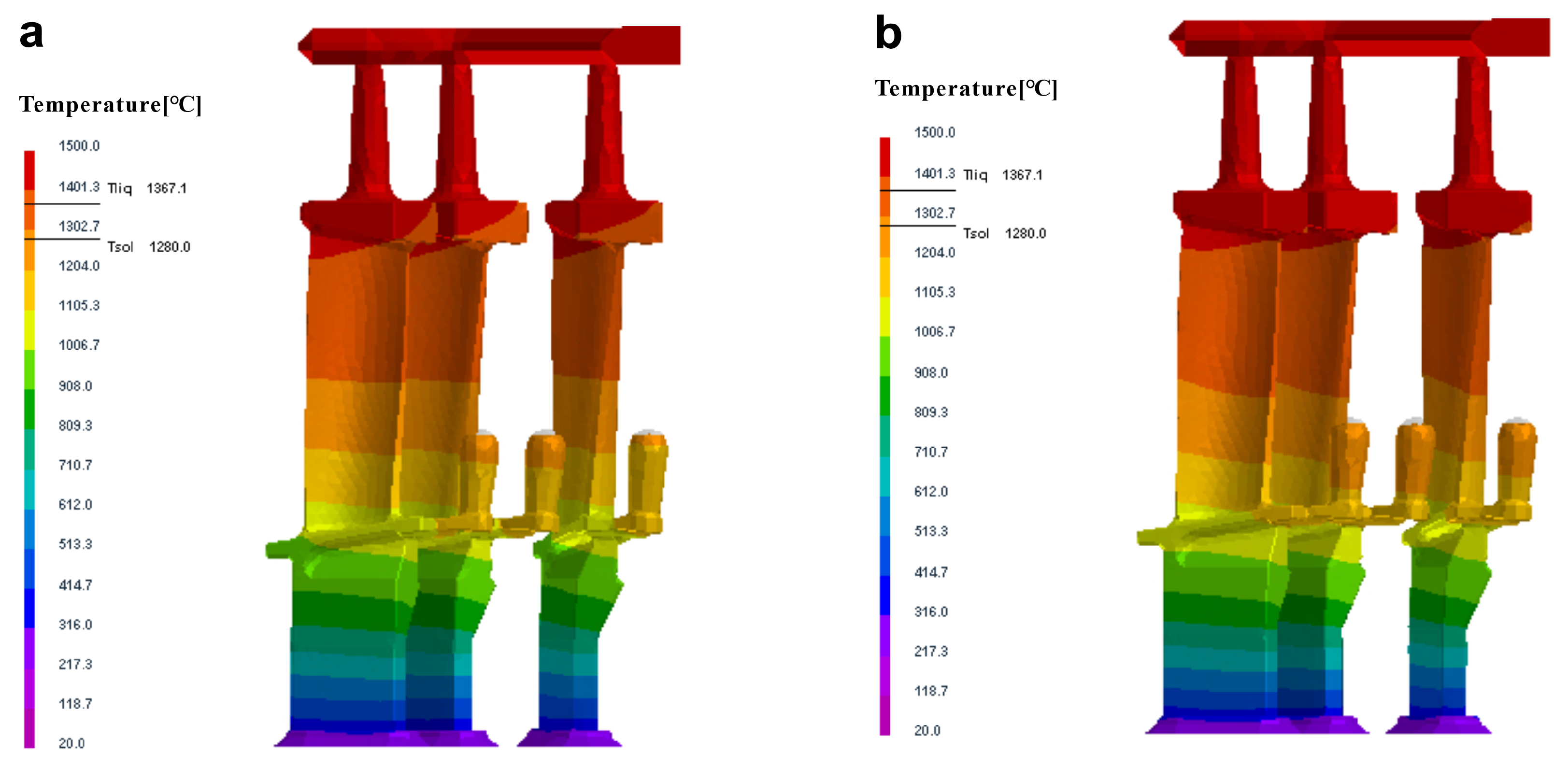




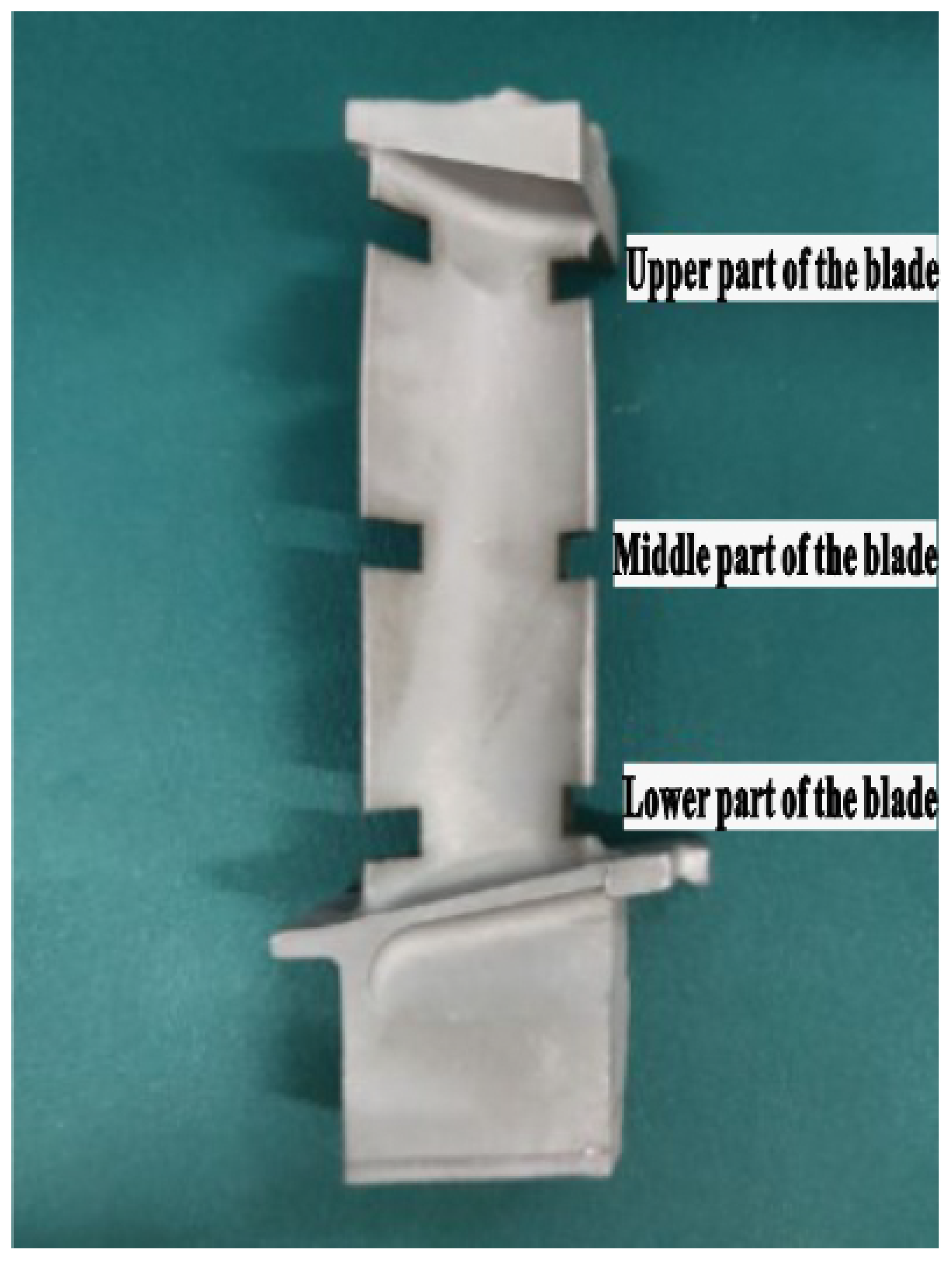
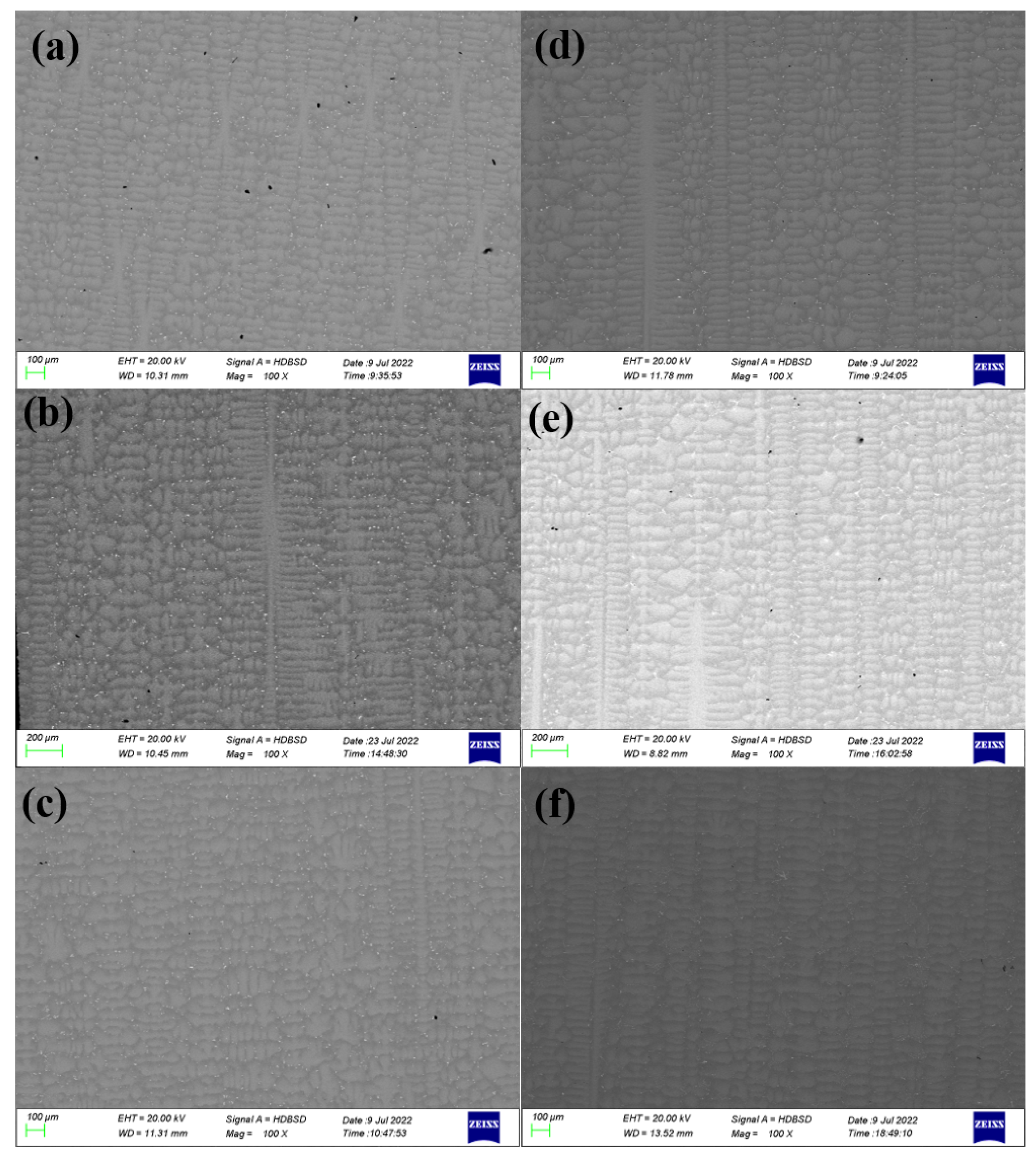

| C | Cr | Co | W | Nb | Ti | Al | Hf | B | Ni |
|---|---|---|---|---|---|---|---|---|---|
| 0.140 | 9.000 | 9.500 | 12.000 | 0.900 | 1.900 | 4.900 | 1.000 | 0.015 | 60.645 |
| Parameter (Unit) | Value |
|---|---|
| Heating zone temperature (°C) | 1500 |
| Cooling water temperature (°C) | 26 |
| Pumping speed (mm·min) | 6 |
| Heating zone emissivity | 0.8 |
| Mold shell emissivity | 0.4 |
| Mold shell density (kg·m) | 3970 |
| Specific heat capacity of the mold shell (KJ·kg·K) | 1.28–1.37 (1000 °C–1500 °C) |
| Thermal conductivity of the mold shell (W·m·K) | 9.2–5.9 (600 °C –1500 °C) |
| Interfacial heat transfer coefficient of Alloy and chilled plate (W·m·K) | 2400 |
| Interfacial heat transfer coefficient of Mold shell and quench plate (W·m·K) | 1000 |
| Interfacial heat transfer coefficient of Cooling water and chilling plate (W·m·K) | 2500 |
Disclaimer/Publisher’s Note: The statements, opinions and data contained in all publications are solely those of the individual author(s) and contributor(s) and not of MDPI and/or the editor(s). MDPI and/or the editor(s) disclaim responsibility for any injury to people or property resulting from any ideas, methods, instructions or products referred to in the content. |
© 2023 by the authors. Licensee MDPI, Basel, Switzerland. This article is an open access article distributed under the terms and conditions of the Creative Commons Attribution (CC BY) license (https://creativecommons.org/licenses/by/4.0/).
Share and Cite
Hu, B.; Xie, W.; Zhong, W.; Zhang, D.; Wang, X.; Hu, J.; Wu, Y.; Liu, Y. The Effect of Pulling Speed on the Structure and Properties of DZ22B Superalloy Blades. Coatings 2023, 13, 1225. https://doi.org/10.3390/coatings13071225
Hu B, Xie W, Zhong W, Zhang D, Wang X, Hu J, Wu Y, Liu Y. The Effect of Pulling Speed on the Structure and Properties of DZ22B Superalloy Blades. Coatings. 2023; 13(7):1225. https://doi.org/10.3390/coatings13071225
Chicago/Turabian StyleHu, Bing, Wei Xie, Wenhui Zhong, Dan Zhang, Xinming Wang, Jingxian Hu, Yu Wu, and Yan Liu. 2023. "The Effect of Pulling Speed on the Structure and Properties of DZ22B Superalloy Blades" Coatings 13, no. 7: 1225. https://doi.org/10.3390/coatings13071225
APA StyleHu, B., Xie, W., Zhong, W., Zhang, D., Wang, X., Hu, J., Wu, Y., & Liu, Y. (2023). The Effect of Pulling Speed on the Structure and Properties of DZ22B Superalloy Blades. Coatings, 13(7), 1225. https://doi.org/10.3390/coatings13071225






